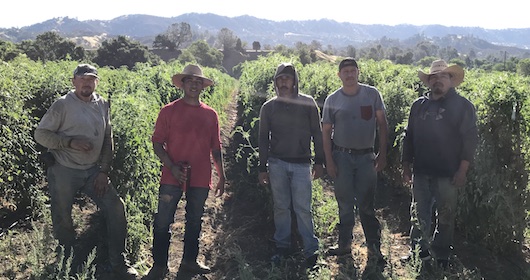
Alfredo’s crew picking tomatoes —
I want to comment on an Opinion that appeared on July 16 in the New York Times, “The Sad Lesson From California.” The article laments the lack of union representation for farm labor in California despite statute that allows union organizers on farms. The author states that despite the right to collective bargaining, farm worker “wages and conditions are for the most part arguably no better than decades ago.”
The reason it came up was because of a law that was just passed in New York that guarantees the right of farmworkers to organize and in its final version requires paid time-and-a-half after 60 hours of work. The thesis of the article, that California serves as an example of failures to protect farm workers, definitely misses the mark in neglecting to mention some really important ways that there have been improvements.
California is one of three states with heat-related labor standards and California’s regulations, developed in 2005, are considered the gold standard. While it took years before farmers were in compliance, and certainly there is still room for improvement, California’s law provides many important protections. Thankfully, journalists plus enforcement activities have helped to raise awareness in many outdoor industries that heat illness is dangerous. California also just passed a regulation to protect outdoor workers from wildfire smoke inhalation, requiring N95 respirators when air quality reaches a specified level.
California is well on the way to requiring overtime pay for farmworkers after 40 hours (that will happen January 2022). The current standard is that time-and-a-half kicks in after 9.5 hours in a day or 55 hours in a week. Again, the California standard is well ahead of the law just passed in New York, and one of the best standards in the country from a farm worker point of view.
California’s minimum wage is also pretty competitive — currently at $12/hour and going to be $15 by January, 2022. In other states where fresh fruits and vegetables are grown, for example Florida, the minimum wage is $8.46/hour and in the state of New York it is $11.10. It’s quite possible that the higher minimum wage in California puts the cost of our fruits and vegetables at a disadvantage compared to those grown in other states. Wages, workers compensation and health insurance are now 60% of expenses at Full Belly Farm. Maybe we should tack on a service charge to fund benefits for our crew — the way that a lot of restaurants are doing these days — but I don’t think it would fly with many of our customers!
A more relevant story than the one that appeared in the Times, is that California has some of the best labor standards in the country. How that reality impacts small businesses, take home pay for farm workers, working conditions and quality of life are subjects worthy of exploring.
In other News From the Farm, we celebrated Akan’s 80th Birthday at the South Berkeley farmers market last Tuesday. Akan has never missed a week of market since 1995 and has been a remarkable presence at our stand. He doesn’t like to have his photograph published, but if you go by the market, you can congratulate him for his many years of amazing service and dedication. Thank you Akan!
— Judith Redmond

Hazel showing a zucchini that got away from us.
